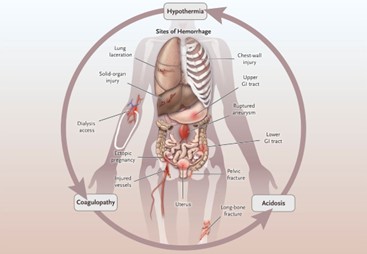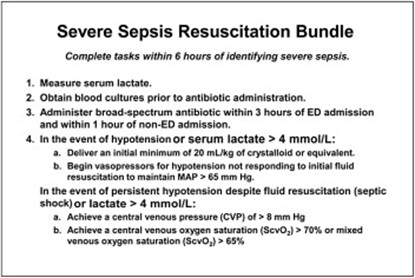The emergency department nurse reviews the medical record of a 41-year-old male patient with hemorrhagic shock, which contains the following information.
Physical Assessment Findings Pulse 140 beats/min and thready
Diagnostic Findings ABG respiratory acidosis
Blood pressure 60/40 mm Hg Respirations 40/min and shallow
Lactate level 7 mmol/L
All of these provider prescriptions are ordered for the patient. Which does the nurse carry out first?
Give Plasmanate 1 unit now.
Prepare for endotracheal intubation.
Give normal saline solution 250 mL/hr.
Type and crossmatch for 4 units of packed red blood cells (PRBCs).
The Correct Answer is C
Hemorrhagic shock is characterized by severe blood loss, leading to inadequate tissue perfusion and hypovolemia. The primary goal in the initial management of hemorrhagic shock is to restore intravascular volume and improve tissue perfusion. Administering intravenous fluids, such as normal saline solution, is a critical intervention to address hypovolemia and improve blood pressure.
A. Give Plasmanate 1 unit now in (option A) is incorrect because: Plasmanate is a plasma-derived product used to replace coagulation factors. While it may be necessary to address coagulation abnormalities, administering intravenous fluids to restore volume takes priority over specific blood products.
B. Prepare for endotracheal intubation in (option B) is incorrect because Endotracheal intubation may be required in cases of impending respiratory failure or compromised airway, but it should not be the first action in addressing hypovolemic shock.
D. Type and crossmatch for 4 units of packed red blood cells (PRBCs) in (option D) is incorrect because transferring packed red blood cells is an important intervention to address blood loss and improve oxygen-carrying capacity. However, before administering blood products, it is crucial to stabilize the patient's hemodynamics through fluid resuscitation.
Therefore, in a patient with hemorrhagic shock, the nurse's first priority among the given options is to give normal saline solution of 250 mL/hr to restore intravascular volume and improve tissue perfusion.

Nursing Test Bank
Naxlex Comprehensive Predictor Exams
Related Questions
Correct Answer is B
Explanation
The patient's symptoms of fever and elevated white blood cell count suggest a potential infection and sepsis. Broad-spectrum antibiotics should be initiated promptly to cover a wide range of possible pathogens until further diagnostic tests and identification of the specific causative agent are obtained. Early administration of appropriate antibiotics is crucial in sepsis management to target the suspected infection and improve patient outcomes.
A. Cooling baths in (option A) is incorrect because: Cooling baths are typically used in the management of hyperthermia or specific conditions like heatstroke. While the patient has an elevated temperature, it is likely due to the systemic inflammatory response rather than solely hyperthermia.
C. Blood transfusion in (option C) is incorrect because Blood transfusion may be required in certain cases of sepsis if there is evidence of significant anemia or active bleeding. However, based on the information provided, there is no immediate indication of a blood transfusion.
D. NPO status in (option D) is incorrect because NPO status (nothing by mouth) is a general precautionary measure used in various situations, such as prior to surgery or to manage gastrointestinal complications. It is not a specific intervention in the sepsis resuscitation bundle.
Therefore, the nurse should initiate the intervention of administering broad-spectrum antibiotics in this scenario.

Correct Answer is B
Explanation
Mean arterial pressure (MAP) is a measure of the average pressure within the arteries during one cardiac cycle. It represents the perfusion pressure that drives blood flow to organs and tissues. MAP is calculated using the formula:
MAP = Diastolic blood pressure + 1/3 (Systolic blood pressure - Diastolic blood pressure)
Blood loss, particularly in cases of significant hemorrhage, leads to a decrease in blood volume. When blood volume decreases, there is less circulating blood available to generate pressure within the arterial system. This reduction in blood volume results in decreased MAP.
Therefore, in the case of massive blood loss after trauma, the student can correlate it with a lower blood volume, which in turn leads to a lower MAP. The decrease in blood volume reduces the perfusion pressure, compromising organ and tissue perfusion
A. It causes vasoconstriction and increased MAP in (option A) is incorrect because: While vasoconstriction can occur as a compensatory mechanism to maintain blood pressure, it does not necessarily lead to an increased MAP in the context of significant blood loss.
C. It raises cardiac output and MAP in (option C) is incorrect because Blood loss typically leads to a reduction in cardiac output due to decreased blood volume. Therefore, it does not raise cardiac output and MAP.
D. There is no direct correlation to MAP in (option D) is incorrect because: There is indeed a direct correlation between blood loss and MAP. As blood volume decreases, MAP decreases as well.
Therefore, the correct correlation between blood loss and MAP is that lower blood volume lowers MAP.
Whether you are a student looking to ace your exams or a practicing nurse seeking to enhance your expertise , our nursing education contents will empower you with the confidence and competence to make a difference in the lives of patients and become a respected leader in the healthcare field.
Visit Naxlex, invest in your future and unlock endless possibilities with our unparalleled nursing education contents today
Report Wrong Answer on the Current Question
Do you disagree with the answer? If yes, what is your expected answer? Explain.
Kindly be descriptive with the issue you are facing.
